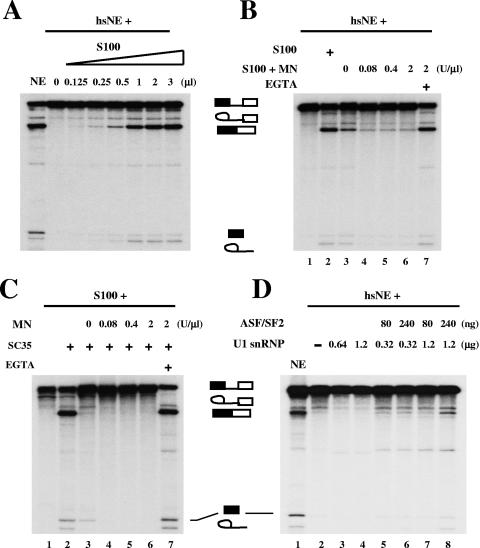FIG. 3.
Rescue of heat shock-induced splicing inhibition by snRNPs. (A) S100 extract can rescue heat shock-induced splicing repression. Increasing amounts of S100 extract were added to splicing reactions containing β-globin pre-mRNA and hsNE. (B) MN-sensitive components in S100 extract can rescue splicing inhibition induced by heat shock. Lane 1, β-globin pre-mRNA splicing in hsNE; lane 2, splicing in hsNE complemented with 1 μl of S100 extract; lanes 3 to 6, complementation of hsNE with pretreated S100 extract with the indicated amounts (units/microliter of S100 extract) of MN; lane 7, hsNE plus MN (2 U/μl)-pretreated S100 extract in the presence of EGTA. (C) snRNPs are defective in MN-pretreated S100 extract. The S100 extracts described for panel B were tested in complementation assays with recombinant SC35 protein. Lane 1, S100 extract alone; lane 2, S100 extract complemented with SC35; lanes 3 to 6, complementation assays of MN-pretreated S100 extracts from panel B with SC35; lane 7, MN-pretreated S100 extract in the presence of EGTA and SC35. (D) U1 snRNP and ASF/SF2 partially rescue heat shock-induced splicing inhibition. Lane 2, splicing of β-globin pre-mRNA in hsNE; lanes 3 and 4, splicing in hsNE complemented with purified U1 snRNP; lanes 5 to 8, splicing in hsNE complemented with purified U1 snRNP and baculovirus-produced recombinant ASF/SF2 protein. Splicing in normal NE was used as a control (lane 1).

